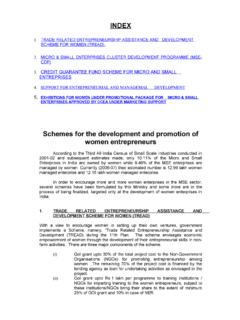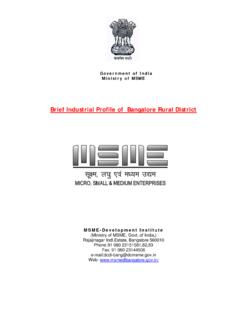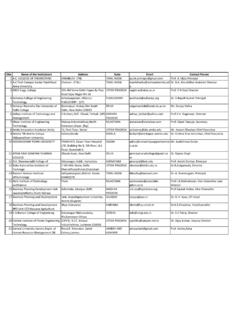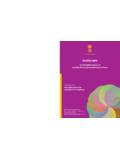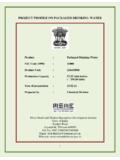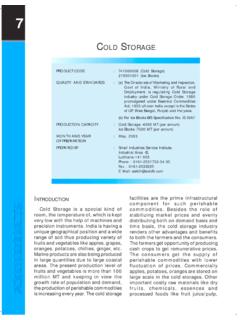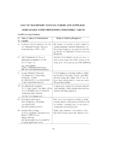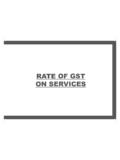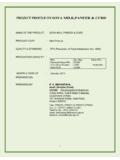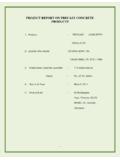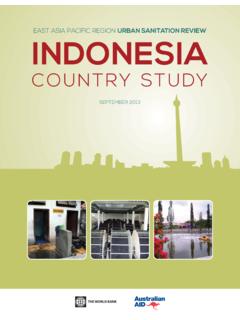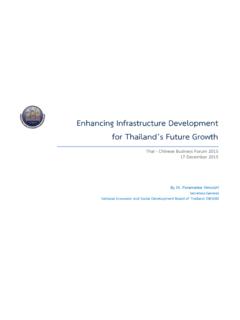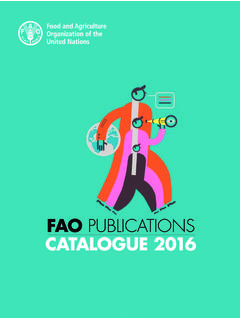Transcription of Ref. No. KNL/DS/Rice-01 - DCMSME
1 Ref. No. KNL/DS/Rice-01 Date: GOVERNMENT OF INDIA MINISTRY OF SMALL SCALE INDUSTRY DIAGNOSTIC STUDY REPORT OF rice MILLING INDUSTRY AT KARNAL (HARYANA) Prepared by: CLUSTER DEVELOPMENT EXECUTIVE SMALL INDUSTRIES SERVICE INSTITUTE MIN. OF SSI,GOVT. OF INDIA 11-A, IDC, KUNJPURA ROAD KARNAL-132001 (HARYANA) PH: 0184-2231862, 2230882, 2230910 DIAGNOSTIC STUDY REPORT ON rice MILLING INDUSTRY AT Prepared by : Kapur Cluster Development Executive 1 INDEX CHAPTER NO.
2 SUB NO. CONTENTS PAGE NO. Executive Summary 1. Introduction 2. Methodology 3. Cluster Scenario 4, Product Range 5. Geographical location-vs- status and trends rice , Production, Yield and area. rice Milling Industry Comprehensive Status in Karnal district 6. Trade & Investment, Export and Issues of significance -Production & Investment -Regulatory Implications -Kharif Procurement Policy -Custom Milling Policy -Marketing & Exports 7. Technology 8 Bench marking clusters 9. Cluster Actors & their Role 10. Core Cluster actors, roles & effectiveness 11.
3 Significant Policies & Issues 12. Present Cluster Map 13. Analysis of Business Operations (AOBO) 14. Kinds of firms & pattern 15. Backward & Forward Linkages & BDS Providers 16. Value chain Analysis 17. Problems Identified 18. SWOT ANALYSIS 19. Strategic Interventions 20. Vision & Objectives 21. Action Plan & Schedule 22. Future Cluster Map 2 EXECUTIVE SUMMARY Out of 21 clusters identified in Haryana, the cluster development has been initiated with rice MILLING INDUSTRIES AT DISTRICT KARNAL (HARYANA).
4 The report is based on the data/informations obtained from Industries, Associations, Exporters, DIC, DFSC, FCI, , Agr., APEDA, Min. of Food Processing, NPC & SIDBI etc. The food grain production of Haryana has stood second in country after Punjab in year 2000-01 with and yield of 3088 kg/hectare over an area of million hectares. The estimated paddy production in Haryana in year 2003-04 has been 43 lac MT including 28% Basmati variety. In Karnal district lac MT paddy arrived in Mandis and estimated as Lac MT in 2003-04 with increase of District Karnal, the production of Basmati rice has been 17000 MT with average yield of 1000 Kg/hectare in the year 2002 with decline in area under Basmati cultivation over a period of last 4 years.
5 At world level total rice production is Million Ton in 2002-03 with India s contribution of & China leading the world by producing are 950 rice Milling units in Haryana & 855 are operational in 2003-04. District Karnal owns 221 rice Mills including 8 large/medium units & 19 exporting units. 68 units are in Karnal and 63 units in Taraori with others in Assand, Biana, Gharanda, Gheer, Indri, Jundla, Kunjpura, Nilokheri, Nissing & Nigdu. 151 units have installed capacity of MT/Hr & 35 have 2 MT/Hr. The capacity ranges from MT/Hr to 32 MT/Hr. Karnal Tehsil has milling capacity of 101 MT/hr followed by Taraori with 86 MT/Hr & then Nissing & Nilokheri. During 2002-03, the rice production in district Karnal has been 6 Lac MT worth Rs.
6 1200 Cr. and Exports of 700 cr. The investment in Plant & Machinery has been Rs. 40 crore & employment to 10000 persons and 77% utilisation of installed capacity. The growth trend of rice Milling industry in last 3 years has been on negative side with falll from 306 units in 2000-01 to 260 Nos. in 2001-02 and to 221 Nos. in 2002-03. The down word trend is in the non exporting units. Haryana has however topped the country with 75% exports of Basmati rice to the tune of about 1200 crores with share of Karnal district to be 58% in 2002-03. The trade is affected by regulating controls of Govt. of India & State Govt. with announcement of minimum support price (by ) for Khariff crops including paddy against Kharif procurement policy every year.
7 Under which the minimum support price for the paddy is ensured to the farmers while auction In case of price falling down, the 6 Govt. designated agencies come forward & take up bulk purchases and help maintaining MSP besides the rice millers in the State are bound to deliver 75% of the rice produced out of leviable Paddy to the central pool at the price & specifications determined in the policy. Under the states custom milling policy the State procurring agencies get the paddy milled from rice milling units at the determined price, specification & terms and deposit to the central pool. The exports is made to USA, UK, European Union, Saudi Arabia, Kuwait, UAE, Phillipines, Malaysia, Bangladesh & non Basmati rice exported to Phillipines, Malysia, Saudi Arab, Bangladesh & Indonesia.
8 The 3 Brown Basmati rice is exported to UK & European Union who further process it as per customized needs. In world market India s stood second in year 2002 with million tons rice exports after million tons by Thailand out of total exports of million tones, The trend in Non Basmati rice exports has been encouraging in last 3 years with % increase of 6 times in year 2002-03. In Basmati rice exports the trend is lowering in last 3 years with reduction by in year 2002-03 with respect to year 2000-01. Most of the rice milling units have installed local fabricated unstandarised milling plants leading to low productivity, high broken & unshelled paddy %age & other rejections.
9 Very few units including large & medium have installed semi/fully automatic plants leading to good quality, productivity and low rejections. Most of the SSI rice millers are not aware of & not following standardization, quality assurance, management systems and also are not aware of right processing techniques including parboiling drying, storage techniques, polishing methods, Bran stablisation, energy conservation & Pollution control. Effective marketing & exports procedure leading to low quality, productivity, high cost of production. Haryana & Punjab are considered to be the bench marking clusters in the country but lacking in advanced & modernized technology & effective quality assurance and management systems.
10 In International market, Thailand, USA & UK have been termed as the best clusters with advanced technology, quality assurance system and management systems. The cluster actors include industries, associations, supporting institutions & BDS providers. The associations in District Karnal mainly exist as rice Millers associations at Karnal, Taraori, Gharanda, Nissing, Indri, rice Exporters Associations & local chapters of Haryana rice Millers Associations. The supporting institutions include APEDA, Min. of Food Processing, DFSC, FCI & Procurring agencies certification agencies, SIDBI, Banks, State Inds. Deptt, SISI, Govt. of India, PPRC, ICAR, CRRI, Agricultural Universities, NPC, IIP, DGFT, ECGC, EIC etc.
